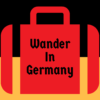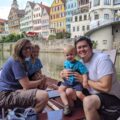Whether you live in Germany and are looking for weekend getaway ideas or are planning your perfect trip and only have 2 days to fill in some time on your itinerary, there are some amazing city breaks in Germany that are just MADE for a weekend or even a few days.
Now, I’m not talking about how you can squeeeeeze Munich in 2 Days or how to do 2 Days in Berlin. While I have those itineraries on the site, they are still not ideal (both those cities deserve WAY more than 2 days in Germany!)
No, I’m talking about those absolutely perfect weekend breaks in Germany. Those towns that are so wonderful in their own rights but don’t really need more than just a couple of days to truly experience them.
So, I went straight to the streets (well, Blogosphere) to ask my fellow bloggers where they would spend a quintessential weekend in Germany. What I love about this list is that there is a great combination of popular locations that tourists love but also some less touristy weekend trips in Germany that are really underrated gems!
Regensburg
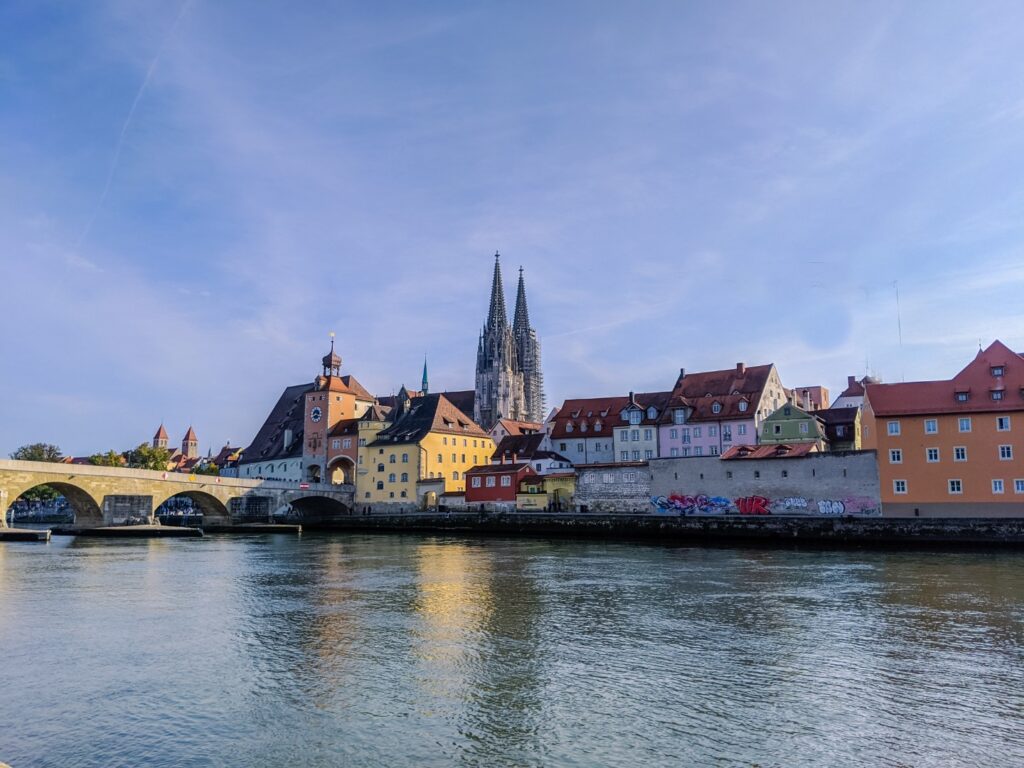
Ok, Ok, I may be a bit biased since I call this UNESCO World Heritage site “Home” now, but after you spend even 1 day in Regensburg, you’ll understand why this is an absolute must for an absolutely perfect weekend in Germany!
Planning a Trip to Germany? Join Our Fantastic Traveling in Bavaria Facebook Group!
And if you are looking for a romantic getaway in Germany, it’s also a fabulous choice, as the general ambiance and vibes of the Innenstadt (Old Town) is charming, quaint, and quintessential “Europe!” With the pastel houses, small cobblestone alleyways, and cafes lining just about every passageway and lane, it’s easy to get sucked into the laid back feelings that everyone seems to have. While you can do Regensburg in a day (for example, as a Day Trip From Munich), having 2 to really deep dive and explore and to go slow is ideal.
Day 1
Take my DIY Walking Tour of Regensburg. This will take you to every single main sight in the Innenstadt while still allowing for time to sit back at a local beer garden. On this walking tour you will:
- See the famous Dom (Cathedral) looming over the Danube River
- Explore the main squares of Haidplatz, Bismarkplatz, and Neupfarrplatz
- See an ancient Roman gate over 1,000 years old
- Go where the locals go for a Biergarten and view of the town
- Walk over one of the oldest stone bridges in Europe
- Eat at the oldest “Fast Food” restaurant in the world
Day 2
While you may have seen all the highlights in the Innenstadt, you won’t want to leave Regensburg quite yet. For day 2 I recommend one of the following options:
- Take a boat ride to the Weltenburg Kloster. This is one of the oldest (still working) monastic breweries in the world and has some AMAZING beers! The boat ride winds you down the gorgeous Donau River and to the picture perfect monastery, which has a small chapel, wonderful walks, and a fantastic beer garden.
- Drive to the Burgruine Donaustauf (Donaustauf Castle) which is a marvelous, small, ruined castle perched on the hilltops above the Danube, and then drive the 3 minutes or hike over to the Walhalla, a huge, Parthenon styled temple that is a “hall of fame” to various figures of German history.
- If you have a full day and plenty of energy, do both! Do the castle and Walhalla in the morning and the Weltenburg Kloster in the afternoon!
If you are looking for other great places to eat in Regensburg, the Bischofhof am Dom is wonderful and atmospheric or the Spital Brewery offers unparalleled views of the town. For something a bit more for those doing weekend getaways for couples in Germany, I suggest the elegant Orphee French Restaurant.
Contributed by LeAnna of WanderInGermany
Goslar
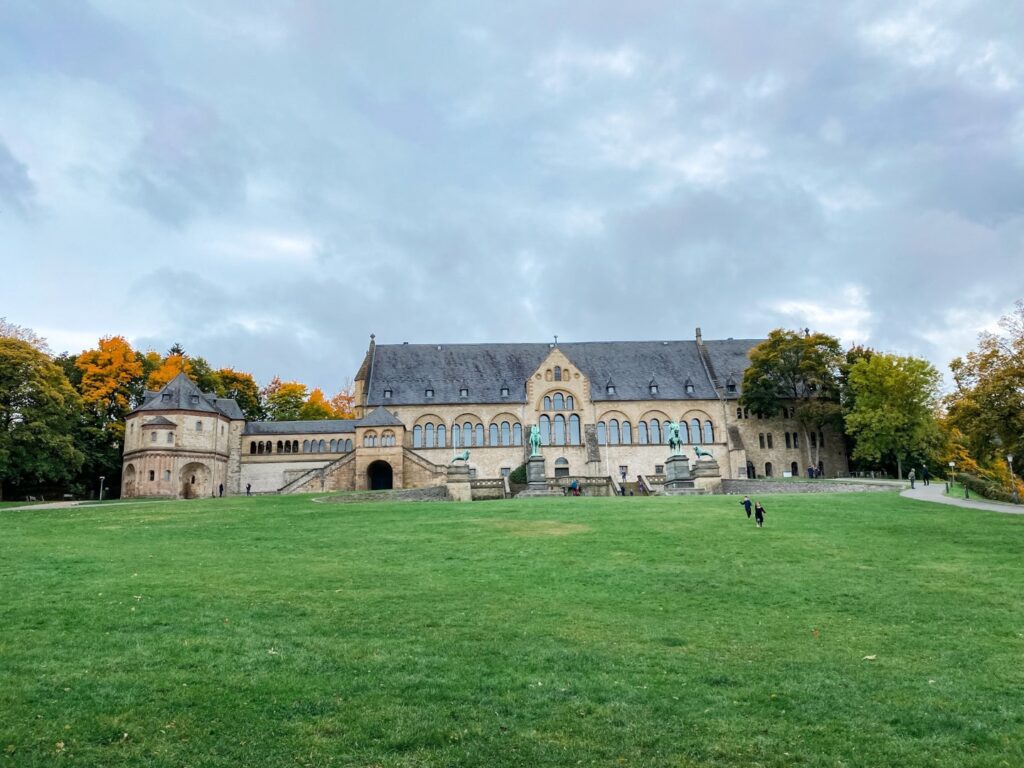
Nestled in Germany’s Lower Saxony’s Harz region is a small, but mighty, 1,000-year-old town called Goslar. As a UNESCO city, it’s rich with history, oozes charm, and can satisfy one’s wanderlust in just a couple of days.
Goslar is located about an hour south of Hanover, and it’s also the closest mountain range to Berlin (3 hours away), making it a great choice for those looking to get out of the city for weekend trips from Berlin and to spend time outdoors.
While a car is nice to have (in case you want to see sites just outside the city; see below) most places in Goslar can be reached on foot; the train station is near Old Town.
Here are the top things to do in Goslar:
Check out the Altstadt
This pedestrian-friendly zone is impressive and beautiful all on its own, but what makes it even more amazing is that all of the old town’s 1500 half-timbered homes were spared during WWII. The reason? Goslar was home to an American POW camp.
While in the Marktplatz…
Take a look at the fountain. It tells a tale as old as time…well, not that old, but pretty old. The lower basin dates back to the 12th century (and was the largest piece of bronze anywhere at the time), and the gold eagle on top used to be actual gold.
While you’re there, look up at the clock on the gray building across from the Rathaus. At 9am, noon, 3pm, and 6 pm the three little doors will open and little figures come out, along with music, to sing about the town’s history.
Take the Train
One fun way to see Goslar is by a little tourist train. Find the train by the front of the Marketekirche Goslar St. Cosmas und Damian, and enjoy a 35-minute, 6.5 km loop around town.
The train travels along the old city wall, next to the Imperial Palace, and other interesting landmarks. This is especially fun for families traveling in Germany.
Check out the Rammelsberg Mine
This ore mine is what really put Goslar on the map, way back in the day. It was the only mine in the entire world that was in continuous operation for more than 1,000 years. It shut down in 1988, but visitors can now take a guided tour and explore inside a mine and/or check out the museum.
See the Imperial Palace
When the Rammelsberg mines opened, Goslar became the largest city outside of the Holy Roman Empire. And with that, came the Imperial Palace. Built in the 11th century, this Kaiserpflaz is filled with history and was once even called “The Rome of the North,” but today it’s open to the public as a museum and arthouse.
Visit a Stave Church
Just outside of Goslar is a spectacular Norwegian-style stave church. The Gustav Adolf Stave Church was built in 1907 from spruce trees, and welcomes visitors inside; it also still holds regular church services. The craftsmanship seen inside and outside of this church is astonishing, and the inside is even more picturesque.
Contributed by Jessica Lynn from JessicaLynnWrites.com
Heidelberg
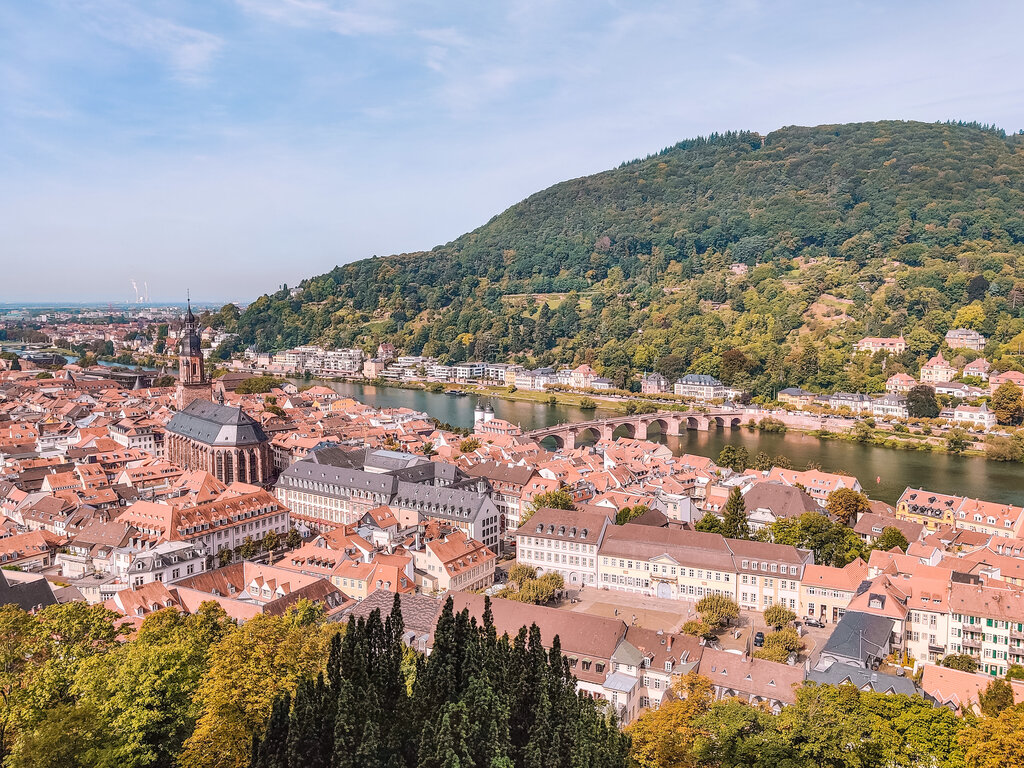
- Visit the Kurpfälzisches Museum
- Stop at the Studentenkarzer
- People watch or grab a coffee at the Marktplatz
- Go into Church of the Holy Spirit
- Get great views at the Kornmarkt
- Walk the Old Bridge
- Do Philosopher’s Walk
- Take the Funicular to Königstuhl
- Visit the Schloss Heidelberg
- See the Heidelberg Tun
- Wander the Botanical Garden in the University of Heidelberg
- Enjoy the Neckarwiese Garden
Contributed By Soujanya Rai from TheSpicyJourney.com
Garmisch
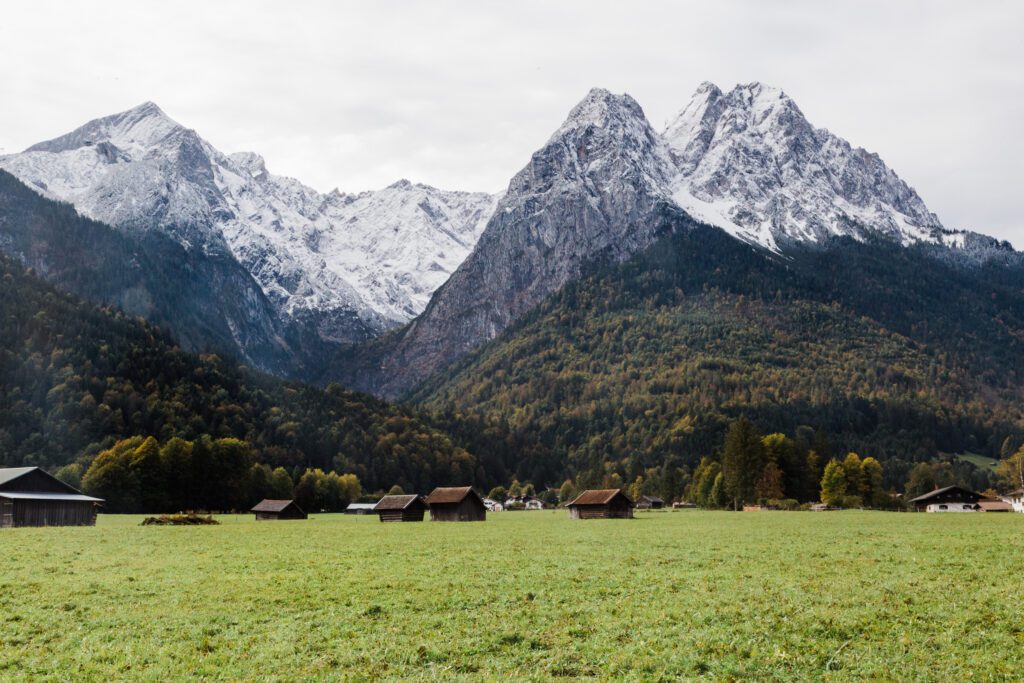
Garmisch is arguably one of the best German city breaks! It’s the outdoor lover’s dream with so many hiking trails, bike paths, walking trails, and mountain vistas all around. Garmisch is in southern Bavaria, just a short distance away from the Austrian border and is known for it’s stunning Alpine backdrop and picture perfect village.
Garmisch is one of the most popular weekend trips from Munich, which is just a one hour drive south from the city. It is best explored with a car, but you can also take the train from Munich using the Bayern Pass and using the local buses to get around.
(Lake) Konstanz
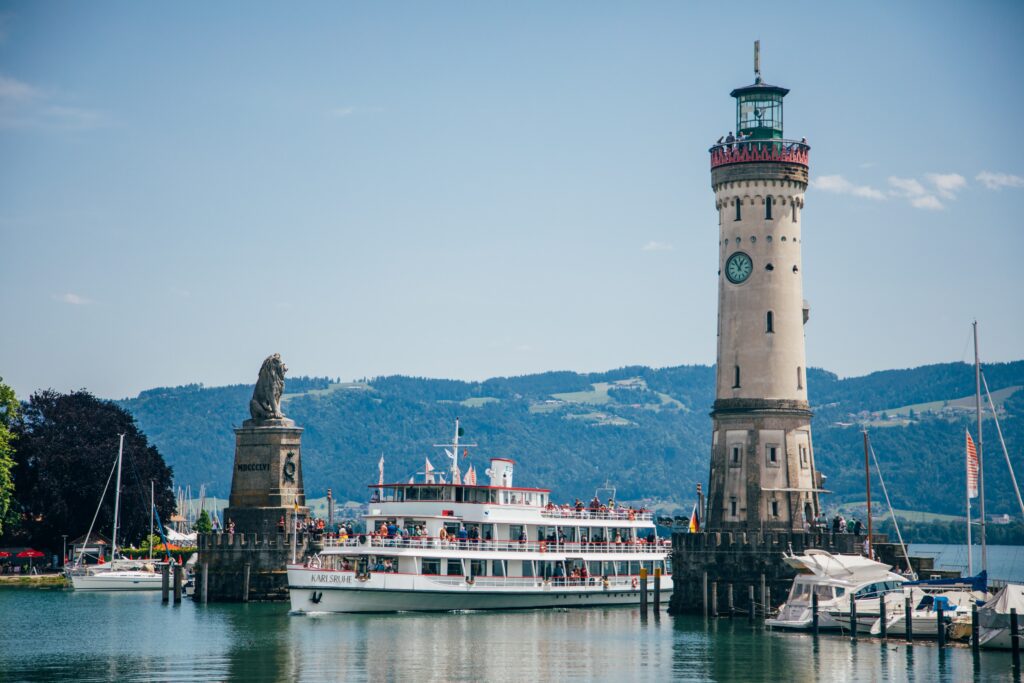
- Riding your bike to Seestraße for a beautiful view of Konstanz from across the bridge
- Stroll through the Old Town (Niederburg) with its historic buildings, fountains, and cobblestone streets
- Relax in Herosé Park right where the river Rhein flows into the lake
- Visit the Konstanzer Rheinstrandbad to jump into the refreshing water on a hot day
- Rent a stand-up paddleboard or go kayaking on the lake
- Visit the harbor of Konstanz
- Climb the steps to the top of Konstanz Cathedral for the best view of the town from above
- Check out the farmer’s market to get some local treats, in case you’re in Konstanz on a weekend
- Have breakfast in one of the lovely cafés, such as Stadtkind Konstanz, Das Vogelhaus or Cafe Bloggers (it’s recommended to reserve in order to get a nice spot)
- Indulge yourself with a nice exotic Lebanese dinner at Ikrams or Six Senses for Asian fusion
Dresden
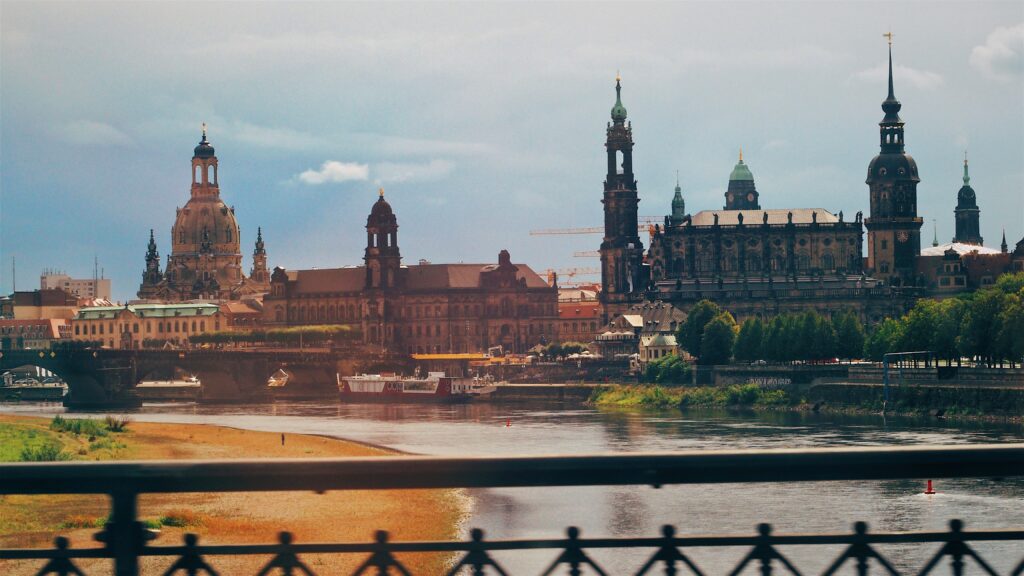
Dresden is gorgeous and packed with history. Here’s what you should see and do on your weekend in Dresden (or a few days).
Old Town: Many of Dresden’s main sights are in the old town, and it’s worth going for a stroll to get a feel for the area. Wander through the Altmarkt and Neumarkt squares, admire the impressive architecture, and check out the Elbe River.
Frauenkirche Dresden: This Lutheran church was built in the 1700s but destroyed during World War II. It stood in ruins for 50 years until donations from around the world came in to rebuild the church.
Zwinger Palace: This Baroque Palace was built for Augustus the Strong. Not only is it a gorgeous building, but the ornate gardens are an attraction on their own. The building now houses a museum.
Brühl’s Terrace: The Elbe River cuts through Dresden, and one of the best places to see it is Brühl’s Terrace. This is a scenic walkway in the location of the old city ramparts, and it’s worth going for a stroll to admire the architecture and the views.
Dresden Castle: This castle was home to the kings of Saxony for more than 400 years, and it’s an important example of Dresden’s Renaissance architecture. It was damaged in WWII, and even though reconstruction started in 1985, the work is still ongoing.
Fürstenzug: Make sure you check out this attraction, which is a mural made of 23,000 tiles. The mural shows portraits of 35 kings, dukes, and other important figures from Saxony. It is considered to be the world’s largest piece of art made of porcelain.
Semperoper: This is Dresden’s opera house, which is a great place to see a show. But even if you don’t have time, it’s worth checking out the building. The neoclassical architecture is impressive, and it dates back to 1667.
Old Masters Picture Gallery: For art lovers, this gallery is a must. Their collection includes 750 paintings from the 15th to 18th centuries, and you can admire pieces from artists such as Rembrandt and Raphael.
Neustadt: Dresden’s old town certainly has its appeal, but if you’re visiting for more than a day, it’s worth going to the other side of the river to explore Neustadt, the new town. You’ll get a more complete view of the city by seeing two very different sides of Dresden.
Striezelmarkt: If you are in Dresden around Christmastime, you can’t miss the Striezelmarkt. This is a wonderful Christmas market that is said to be the oldest one in the world.
Dresden is south of Berlin, so it’s easy to add to a trip to Germany. You can easily get from Berlin to Dresden by train or bus in about two hours or so making it a perfect Berlin weekend trip as well. Dresden Hbf (Central Station) is closest to the old town, but there’s also a train station in Neustadt. It’s easy to get around in Dresden on foot, but the tram system is easy to use if you’re going a little farther. Parking can be tough, so I don’t recommend driving.
Cochem and the Mosel Valley
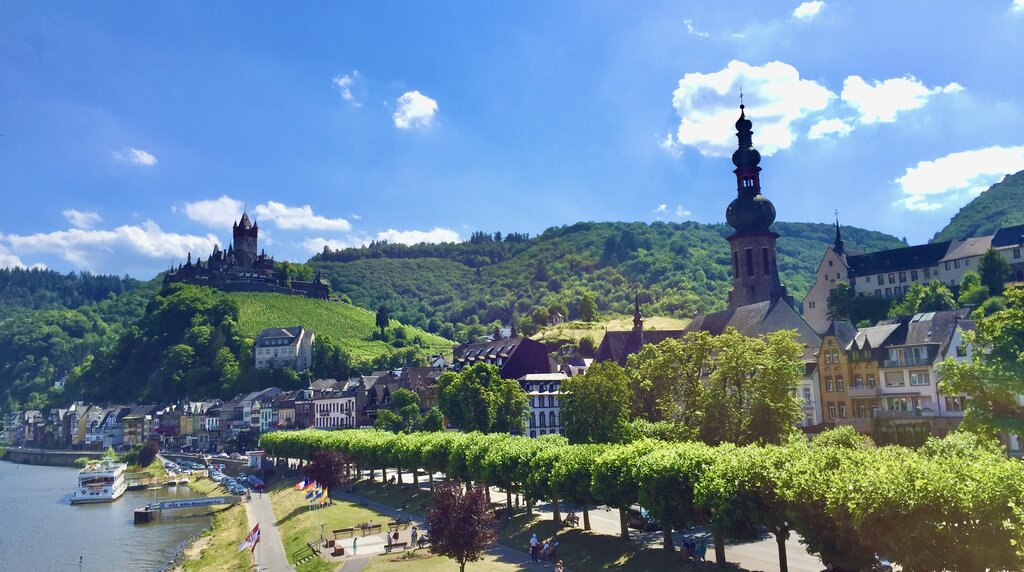
One of the most charming hidden gems in Germany is the Mosel Valley between Koblenz and Trier. While the river winds its way for hundreds of kilometers through southwest Germany, you’ll want to base yourself in or around the town of Cochem. Full of beautiful vineyards and medieval castles, the Mosel Valley is the perfect weekend getaway in Germany.
Due to its central location, Cochem is easily reachable from many major European cities making it a great weekend trip to Germany. Approximate driving times from Brussels, Amsterdam, and Munich are 3, 4, and 5 hours, respectively. The best way to get to Cochem is by car, so having your own vehicle is preferred. It can be accessed by train, however. Just add an hour or two to your journey to take the Deutsche Bahn to Koblenz. From there you can hop on the DB Regional train that travels right down the Mosel, stopping at nearly every village along the way.
Day 1 Famous Vineyards
Even if you’ve driven to Cochem, the train can be your friend once there. The Mosel River Valley is known for producing some of the finest Riesling in the world. The banks of the river are littered with vineyards. If you really want to experience the region, wine tasting is a must and it’s easy to avoid driving under the influence by taking the local train.
Unlike many other famous wine regions though, Mosel operates a bit differently. Instead of visiting vineyards and trying the wines, you’ll typically be wine tasting at the wine shops in the villages (including Cochem). Each winery has a little shop in the nearest town and they’ll tell you all about their wine and let you taste as many as you want. Charges vary depending on the winery. Bottles are usually pretty cheap along the Mosel and you can find good Rieslings for under 10 Euros. Spend your first day exploring the various villages and the wine shops along the river, tasting all the wine you can!
Day 2 Castles
When you’ve had enough wine, the other main draw of the Mosel River Valley is the medieval castles. Spend your second day visiting some of the most recognizable castles in the world. Perhaps the most famous of these is Burg Eltz, about a 25-minute drive from Cochem (and not accessible by train).
Possibly the most beautiful castle is the 11th century Cochem Castle itself. Perched on a hill high above the town, overlooking the river, the castle is the main landmark of the charming little town. In true Mosel fashion, the hill is covered in vineyards and the castle even has its own winery these days.
If abandoned castles are more your thing, then a short hike up to the ruins of Burgruine Winneburg is for you. From the top, you’ll have a nice view of the valley below. If you’ve purchased a bottle of wine the day before, there’s no better place to drink it than this abandoned castle. The Mosel River Valley features numerous other noteworthy castles that are worth a visit too if you have the time, such as Burg Metternich, Burg Thurant, or the ruins of Kloster Sluben. The possibilities are endless!
Contributed By Chris Heckmann from AroundTheWorldWithMe.com
Rothenburg ob der Tauber
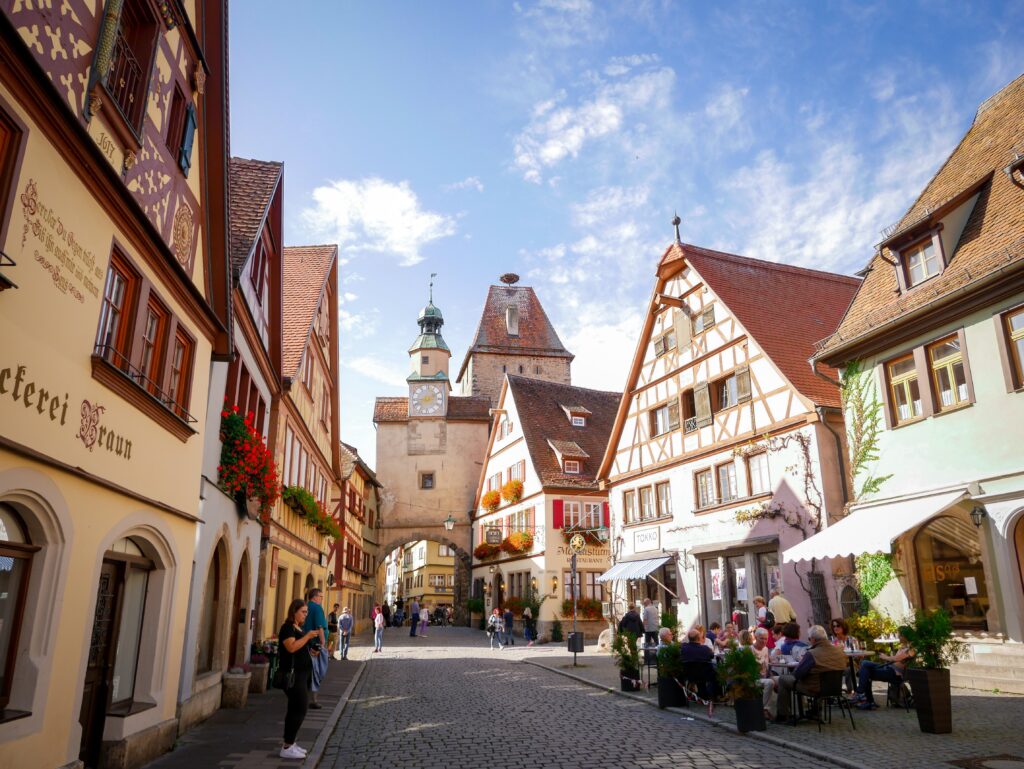
Rothenburg-ob-der-Tauber is a popular touristic city in Southern Germany in Bayern. On a 6 week European road trip Rothenburg is a must-visit stop for 2 days. The city is still completely in medieval style. It’s not a large city so it’s easiest to explore Rothenburg on foot.
There’s a train station in Rothenburg ob der Tauber so the city can (easily) be reached by public transport. The city is on the Romantische Straße, an auto route that starts in Würzburg and ends in Füssen near the famous Cinderella Castle Neuschwanstein. This makes the city also perfectly reachable by car.
Rothenburg is also considered one of the Best Christmas Markets in Germany. Here you can find a 2 Day Christmas Market Itinerary for Rothenburg as well.
A perfect itinerary with 2 days in Rothenburg is the following:
Day 1:
- Buy a Schneeballen. It’s the town’s famous pastry.
- Visit Käthe Wohlfahrt Weihnachtsmuseum, Weihnachtsdorf and shop. The famous Christmas store chain started here in Rothenburg. Buy beautiful wooden Christmas ornaments and admire the Christmas village. The museum has the largest collection of traditional German Christmas decorations in the world.
- Visit the Mittelalterliches Kriminalmuseum. To learn all about how they punished people that committed crimes in the Middle Ages.
- On the Marktplatz watch the Glockenspiel at Ratstrinkstube. The building has a clock and sundial.
- Stroll on over to the Plönlein, the most photographed and Instagrammable place in Rothenburg. There’s a tilted, crooked yellow timber-frame house in the center of the square. Further there’s a fountain and two towers of the old city wall.
- In the evening take a guided city walk, but in the dark, try the Nightwatchman tour to learn all about the ghost stories of Rothenburg.
Day 2:
- Walk on the fortifications of the city. The old walls are still standing and the towers such as Klingentor and the Rödertor. The walls provide breathtaking views on the surrounding countryside. The best view is from the Blick ins Taubertal in the Burggarten.
- Go on a guided city walk during the day, to learn more about the city’s history and the beautiful old buildings in the city.
- Visit the Rothenburg Museum housed in a 13th century monastery. Displayed is the art, culture and history of the city.
For food, you are never lacking in Germany! Have a delicious pastry or as they say in Germany Kaffee und Kuchen at Bäckerei-Konditorei-Café Walter Friedel. Landsknechtstübchen would be perfect for dinner, with traditional German dishes such as spätzle, sauerbraten, and flammkuchen. Another perfect dinner restaurant would be Restaurant Alter Keller with more traditional German dishes such as schnitzel, goulash, and schweinshaxe, where the waiters are dressed in traditional trachten.
Contributed by Cosette from KarsTravels.
Quedlinburg
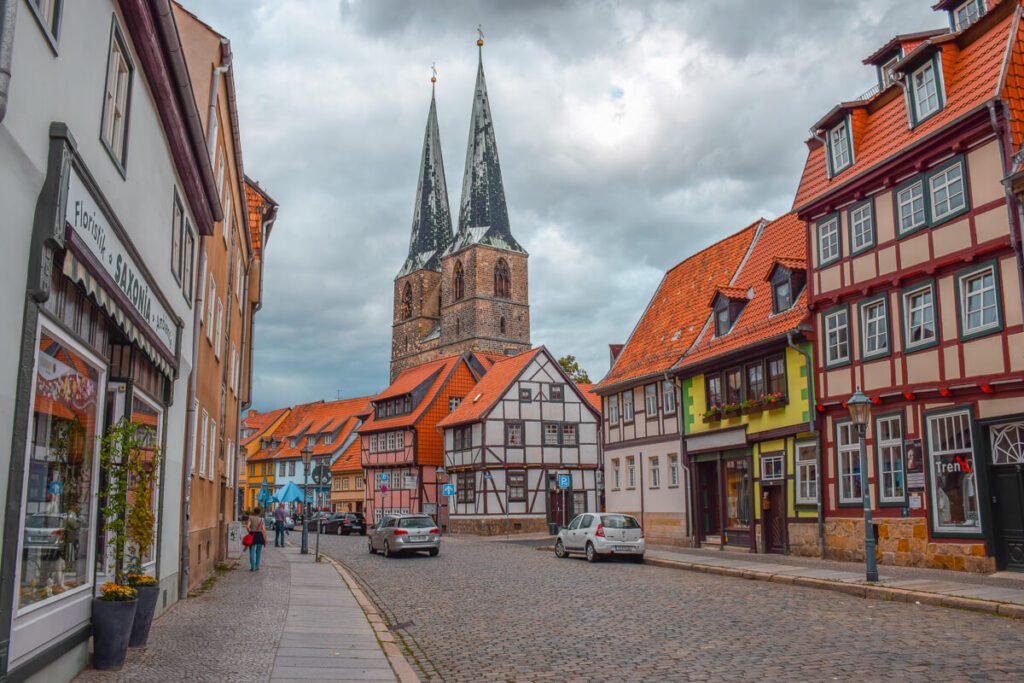
The fairytale town of Quedlinburg is located in Northern Germany, just north of the Harz mountains. It’s the perfect place for short breaks in Germany and weekend trips, as this is just the right amount of time to explore everything the town has to offer.
To get to Quedlinburg, the nearest airport to Quedlinburg is Hanover International Airport, which is approximately 57 km away. Another option is Berlin International Airport (216 km away), from where you can easily reach Quedlinburg within about 3-4 hours by car, train or bus.
The rare combination of ancient, medieval and modern elements make Quedlinburg a destination that’s worth a visit. More and more travelers are discovering Quedlinburg in recent years, making it an emerging tourist destination that is still off-the-beaten-path.
What makes Quedlinburg so special is the fact that it’s an old imperial city and the whole old town is a UNESCO World Heritage Site. Due to this, the facades of all buildings must be preserved, making the whole place look like you’re in a Brothers Grimm fairy tale!
The top places one must visit in Quedlinburg are:
- The Old Town with its traditional half-timbered houses and
- Roam around the Market Square with the city hall.
- Go up to the church of St. Servatius and Castle Museum
- Visit the Quedlinburg museums, such as the Munzenbergmuseum, Schlossmuseum and Klopstockmuseum.
- See the very impressive Hochständerhaus, which may not be the most beautiful one, but it’s considered the oldest half-timbered house in all of Quedlinburg.
Exploring the whole city usually takes no more than one or two days, as it’s quite small and all the attractions are located within a walking distance. The good thing about Quedlinburg is that it hasn’t become overcrowded with tourists (yet) and you can actually roam around freely and take photos with almost no people around!
Quedlinburg is beautiful all-year-round, but its magic really unfolds in the winter season when the Christmas market lights up the whole town!
Contributed By Lyubomira from Bulgarian On The Go
Erfurt
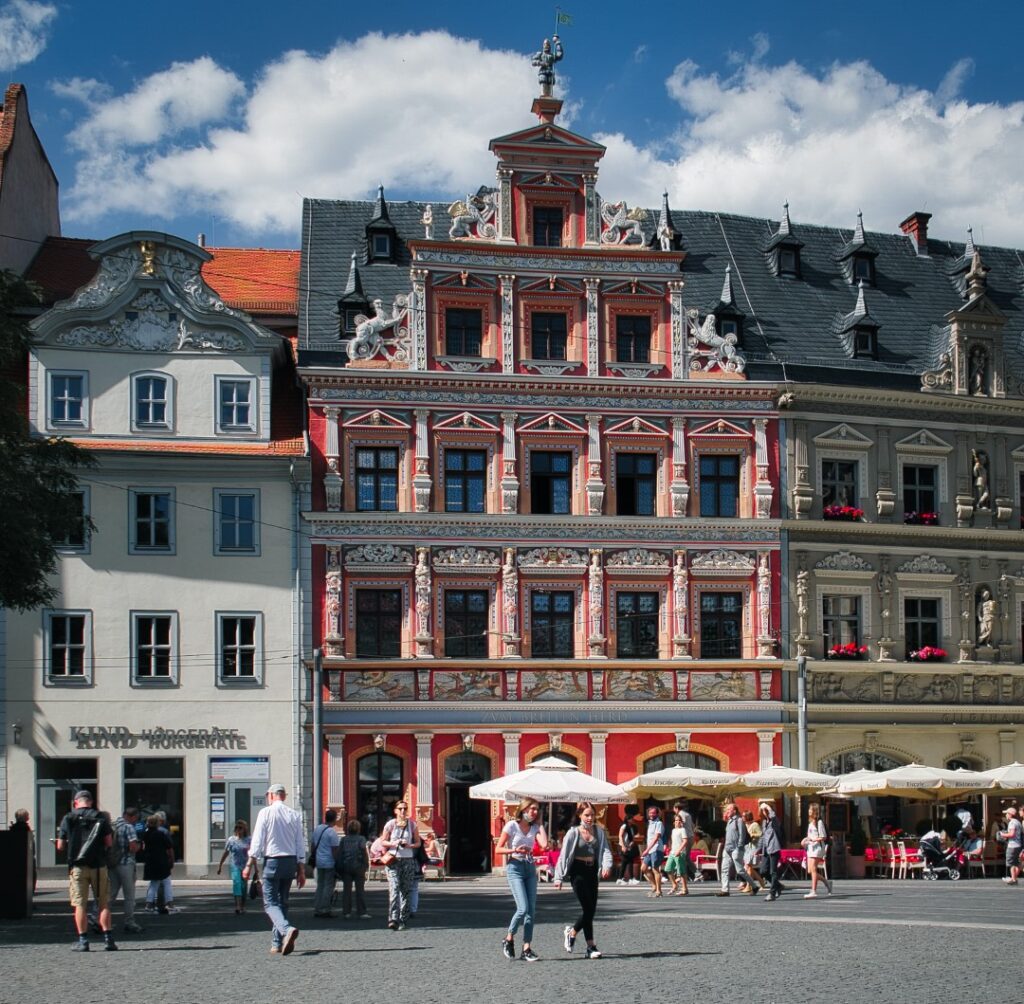
Erfurt is the capital city of Thuringia, one of the 16 regions of Germany and is located in the center of Germany. Because of the green, lush, woodlands landscape, it’s often referred to as “The beating heart of Germany.”
Erfurt is perfect for 2 day Germany getaways or a weekend trip because as a capital city it oozes energy and atmosphere. However, because of its size, it is small enough to explore and enjoy in just 2 or 3 days!
There is a main train station with routes running all over Germany as well as internationally so getting there by train won’t be a problem. Erfurt is approximately 2 hours from Berlin by train and 2 hours from Munich by train. If you are driving in Germany, this is easy with the Autobahn leading straight into Erfurt city and parking availability all over the city.
Trying traditional German food is a must while in Erfurt. The best foods to try in Erfurt include freshly-baked bread from the many bakeries around town, Klosse, or Knödel (which are potato dumplings, popular with pork, sauerkraut, and gravy), and of course bratwursts which can be found in many of the stalls dotted around the center.
Things To Do in Erfurt
Some of the best things to do in Erfurt include:
- Strolling the Gera river that runs through the city and below cobbled bridges and tree-lined streets
- Go shopping in the ‘Anger’ to observe the locals going about their lives
- Seeing the famous Krämerbrücke which is a pretty bridge-over-water in Erfurt center
- Visiting the area known as the ‘Dom’ to see the impressive Cathedral
- Lastly, climb to the top of Petersberg Citadel, snapping a picture with the ‘Erfurt’ sign on the way, and watch the sunset over the city.
Near Erfurt
If you love the culture in Thuringia and want to explore more, some of the best places to visit near Erfurt include Weimar which is the home of German literary icons Goethe and Schiller. Their homes and writing spaces make up a UNESCO site in Weimar! Thuringia is actually home to two UNESCO sites, the other being Wartburg which is a huge fort in the city of Eisenach and is the place where Martin Luther translated the Bible into German.
Contributed by Shireen of TheHappyDaysTravels
Düsseldorf
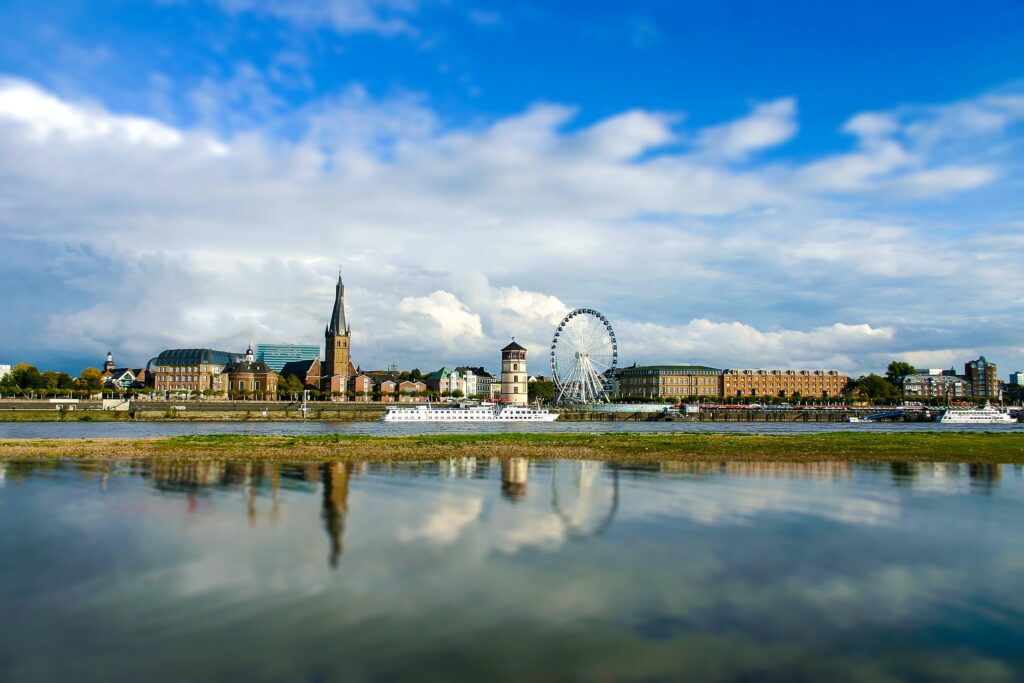
One of the best weekend trips in Germany is one to the city of Düsseldorf. You can find Düsseldorf close to the border with the Netherlands and Belgium, so doing a weekend trip from those countries is very easy to do as well. Moreover, it is one of the larger cities in Germany, with a population of more than 600,000 people, so there are a lot of things to do and see in the city.
It is very easy to reach Düsseldorf by public transport, because of good train connections to other parts of the country and there are also good international connections by train. For example, it is easy to get to Düsseldorf from Brussels. Because of the great train lines and many fast speed trains that come to Düsseldorf, it’s often easiest to come by public transportation than car.
2 Day Itinerary For A Weekend in Düsseldorf
Day 1:
- On the first day, you can go to the oldest part of the city, called the Altstadt. Here, you can find a lot of historic buildings, such as the old City Hall. Also, there are many quaint streets in this part of Düsseldorf and lots of shops to just wander around and enjoy.
- Also, you can find the Königsallee here, which is a great next sight to visit. This is a boulevard with a canal where you can find many (fashion) stores.
- After shopping there, it is great to go to one of the museums in the city. One of the best museums in Düsseldorf is Museum Kunstpalast. This is an art museum with a large variety of objects. There are drawings, sculptures, photos, and other items. Also, this art comes from all around the world.
- You can find this museum close to the Rhine river, and next to the river, there is the Rhine embankment promenade. This is a lovely promenade that is great for a walk while looking at the river. Also, there are many restaurants here that are great for having dinner on this day.
Day 2:
- A great way to start the second day of this weekend trip is by going to Hofgarten. At this place, you can find gardens with beautiful nature. So you can go for a relaxing walk here.
- Next to the Hofgarten, you can find the Kunsthall Düsseldorf. This is a place with good contemporary art exhibitions that you can visit next.
- After that, a great way to end your day is by going to the Rhine Tower. This is one of the most iconic sights in the city where you can get a view of the city. Also, there is a restaurant inside this tower where you can have dinner.
Contributed By Dymphe of Dymabroad
